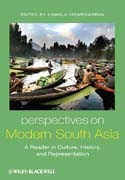
Perspectives on modern South Asia: a reader in culture, history, and representation
Visweswaran, Kamala
Perspectives on Modern South Asia presents an exciting core collection of essays drawn from anthropology, literary and cultural studies, history, sociology, economics, and political science to reveal the complexities of a region thatis home to a fifth of humanity. Presents an interdisciplinary overview of theorigins and development of the eight nations comprising modern South Asia: Afghanistan, Bhutan, Bangladesh, India, the Maldives, India, Pakistan, and Sri Lanka Explores South Asias common cultures, languages and religions and their relationship to its ethnic and national differences Features essays that provide understandings of the central dynamics of South Asia as an important cultural, political, and economic region of the world INDICE: Introduction: Reconceptualizing Region and Nation in Modern South Asia. Part I: Debates about Origins: Pre/Modern Religious Pluralities in SouthAsia. 1. Shail Mayaram. 2004. Beyond Ethnicity: Being Hindu and Muslim in South Asia. 2. Syed Akbar Hyder. Towards a Composite Reading of South Asian Religious Cultures: The Case of Islam. 3. Vasudha Narayanan. 2006. Shared Ritual SpacesHindus and Muslims at the Shrine of Shahul Hamid. 4. Kancha Iliah. 1996. Hindu Gods and Us: Our Goddesses and the Hindus. Part II: The Study of South Asian Society and the Emergence of Modern Forms of Social Classification. 5. Bernard Cohn. 1987. Notes on the History of the Study of Indian Society and Culture. 6. M.N. Srinivas. 1962. A Note on Sanskritization and Westernization. 7. Arjun Guneratne. 2002. Whats in a Name? Aryans and Dravidians in the Making of Sri Lankan Identities. 8. Hamza Alavi. 1989. The Politics of Ethnicity in India and Pakistan. 9. Rajendra Pradhan. 2002. Ethnicity, Caste, and a Pluralist society. Part III: Partition, Nationalism, and the Formation of South Asian National States. 10. Ritu Menon and Kamla Bhasin. 1997. 'Abducted Women, the State and Questions of Honour: Three Perspectives on the Recovery Operation in Post-Partition India. 11. Nighat Said Khan. 1994. Identity, Violence, and Women: A Reflection on the Partition of India 1947. 12. Naila Kabeer. 1987. The Questfor National Identity: Women, Islam, and the State in Bangladesh. 13. Val Moghadam. 1997. Nationalist Agendas and Womens Rights: Conflicts in Afghanistan in the 20th Century. 14. Rizwan Ahmed. 2001. The State and National Foundation in the Maldives. Part IV: States and Communal Conflict in South Asia. 15. Tambiah, Stanley J.. Presidential address: reflections on communal violence in South Asia. 16. Pankaj Mishra, Ayodhya: the Modernity of Hinduism. 17. Darini Rajasingham-Senanayake. 2002. Identity on the Borderline: Modernity, New Ethnicities, and the Unmaking of Multiculturalism in Sri Lanka. 18. Nazif M. Shahrani.2002. War, Factionalism, and the State in Afghanistan. Part V: Development and Liberalization. 19. David Ludden. 2005. Development Regimes in South Asia. 20. Amartya Sen and Jean Dreze. 1996. Radical Needs and Moderate Reforms. 21. Gopal Guru and Anuradha Chakravarty. 2004. Who Are the Countrys Poor? Social Movement Politics and Dalit Poverty. 22. Lamia Karim, Politics of the Poor? NGOsand Grass-roots Political Mobilization in Bangladesh. 23. Seira Tamang. 2002.The Politics of Developing Nepali Women. 24. Sandya Hewamanne 'City of Whores'. 25. Tashi Choden. 2002. Indo-Bhutan Relations: Recent Trends. Part VI: Social Movements. 26. Achin Vanaik. 2001. Developing the Anti-Nuclear Movement. 27. Zia Mian. Pakistans Fateful Nuclear Option. 28. Chitraroopa Palit.2003 Monsoon Risings: Mega-Dam Resistance in The Narmada Valley. 29. Radha Kumar. 1999. From Chipko to Sati: The Contemporary Womens Mov
- ISBN: 978-1-4051-0062-5
- Editorial: Wiley-Blackwell
- Encuadernacion: Cartoné
- Páginas: 392
- Fecha Publicación: 15/04/2011
- Nº Volúmenes: 1
- Idioma: Inglés
